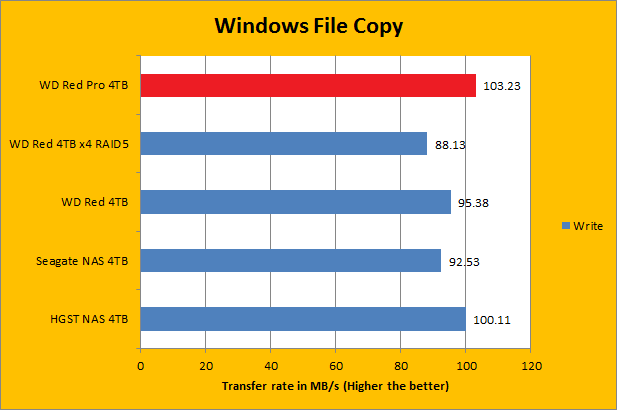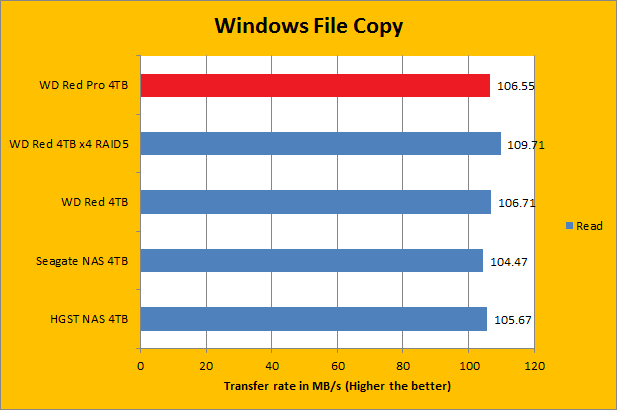Page 10 - NAS Performance, Power Consumption
For our network attached storage tests, I have used the renowned QNAP TS-470 connected to our central home network with CAT5e wiring. The QNAP TS-470 is one of the company's latest SOHO/SMB systems, and is currently the fastest NAS we have tested here at APH Networks. The client computer is the same system used for benchmarking the hard drives as described in Page 2 of this review, which features the excellent Intel 82574L Gigabit Ethernet adapter.


Loaded with different hard disk drives, our QNAP TS-470 is ready to roll. According to the engineers at QNAP, and proven to be true in our performance benchmarks, Intel Gigabit LAN adapters -- at least on the client side -- traditionally performs better than their Realtek and Marvell counterparts. Therefore, to prevent any bottlenecks on the client side, our ASUS P8P67 WS Revolution motherboard is connected to the network via its integrated Intel 82574L Gigabit LAN adapter. We also conducted the above test on our SanDisk Extreme II 240GB solid state drive on the client side to ensure there is nothing limiting the performance of our QNAP TS-470 than the NAS itself. In the write test, both the 7,200 RPM HGST Deskstar NAS and Western Digital Red Pro took the lead in cracking just over 100MB/s; with the WD4001FFSX slightly faster at 103.23MB/s. Meanwhile, the lower RPM NAS drives from Western Digital and Seagate followed closely behind at 95.38MB/s and 92.53MB/s, respectively.
As with our previous results, we had four WD40EFRX 4TB for testing, so a quad HDD RAID 5 array was built to see how the Red drives performed in a real life network attached storage system setup. Because running a RAID 5 array does have quite a bit of operation overhead, especially when it comes to write speed, it was perfectly reasonable to see a performance drop, as you can see in the first graph above. The speed drop was due to factors contributed by the NAS box itself, as well as the hard drives to some extent. I only have one WD4001FFSX for testing, but it is safe to assume a similar performance drop if you were to place several WD Red Pro 4TB drives in the same RAID 5 configuration.
In the read test, all four drives in single mode came out to be extremely close to each other, with the Western Digital Red WD40EFRX 4TB producing a lead by a hair in the overall race. The Western Digital Red Pro WD4001FFSX 4TB was negligibly slower, but the amount was so small, I will call it a statistical tie in this regard. With that in mind, let us see how it performs across the curve in our remote ATTO benchmarks.


ATTO disk benchmark provides valuable insight into evaluating disk performance; it is especially valuable since it is not local disk limited like Windows file copy -- but rather the network adapter itself. After first using it in our QNAP TS-559 Pro+ review back in 2010, ATTO has been an integral part of our storage benchmarks; used in everything ranging from USB flash drives to solid state disks. Venturing in the area of 118MB/s in read and write for pretty much everything 32K and up, remember that the theoretical maximum of Gigabit Ethernet is 'only' 125MB/s (1000Mbps / 8) with overhead -- this is downright impressive. Interestingly, all three hard drives had almost identical performance curves when deployed, unlike what we have seen on Page 4 of this review. With four Western Digital Red WD40EFRX 4TB hard drives running in RAID 5, there was a speed penalty at 32K and above, as expected. Again, I would assume a similar performance drop if four Western Digital Red Pro WD4001FFSX 4TB hard drives were configured the same way.


With one hard drive installed, our QNAP TS-470 consumed the most power with Western Digital's Red Pro WD4001FFSX 4TB installed; tying the HGST Deskstar NAS 4TB, another 7,200 RPM model. Consider most network attached storage systems will be running 24/7, and there will more than likely be multiple hard drives installed, every watt will definitely add up on your power bill. When idling, the entire system equipped with the regular WD Red took only 25W, whereas the same system configured with the speedy but hungry 7,200RPM Hitachi Deskstar NAS and Western Digital Red Pro took 28W -- a whopping 3W difference for just one drive alone. Interestingly, this was not the case in our load tests. The system equipped with the WD Red Pro 4TB tied the Seagate NAS HDD 4TB at 37W, which was only one watt higher than the most efficient of the pack, the original WD Red 4TB.
With four WD40EFRX installed, you can really see how it all adds up. While idling, the system took 35W; loading it up boosted this figure to 52W. How will this compare if we were to have four Red Pro WD4001FFSX 4TB disks? To extrapolate the graphs a bit, this means running quad WD Red Pro drives concurrently will probably take 47W idle and 56W load at my guess. The Western Digital Red Pro, a fast enterprise grade drive, will run you a few bucks more per month on your power bill. That said, while it did not consume the least power at idle, its load efficiency was surprisingly good.
Page Index
1. Introduction, Features, Specifications
2. A Closer Look, Installation, Test System
3. Benchmark: AIDA64 Disk Benchmark
4. Benchmark: ATTO Disk Benchmark
5. Benchmark: Crystal Disk Mark 3.0
6. Benchmark: HD Tach 3.0.1.0
7. Benchmark: HD Tune Pro 4.60
8. Benchmark: PassMark PerformanceTest 8.0
9. Benchmark: PCMark 7
10. NAS Performance, Power Consumption
11. Conclusion





